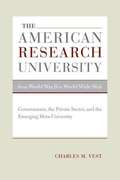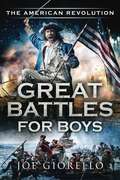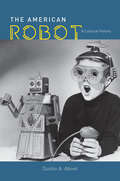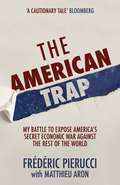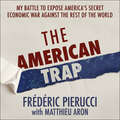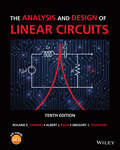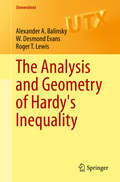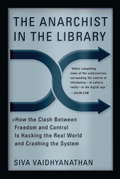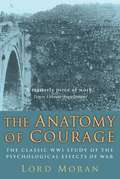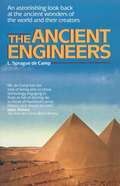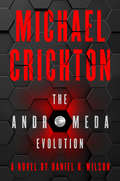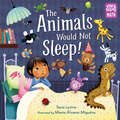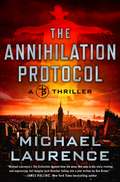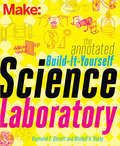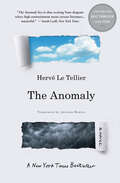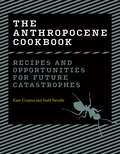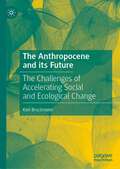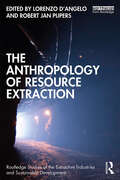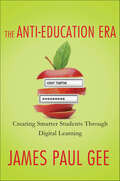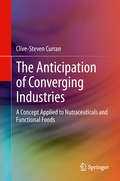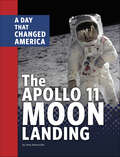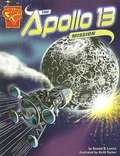- Table View
- List View
The American Research University from World War II to World Wide Web: Governments, the Private Sector, and the Emerging Meta-University
by Charles M. VestThis volume provides a unique opportunity to explore the current state of the research university system. Charles M. Vest offers a multifaceted view of the university at the beginning of a new century. With a complex mission and funding structure, the university finds its international openness challenged by new security concerns and its ability to contribute to worldwide opportunity through sharing and collaboration dramatically expanded by the Internet.
The American Revolution (Great Battles For Boys)
by Joe GiorelloFrom Concord and Lexington to Brandywine and Yorktown, the stunning battles show young readers how ragtag colonists took on the world’s mightiest military of its time — the British Imperial Army, otherwise known as the Red Coats. <p><p> History leaps off the page and captures even reluctant readers as early colonial protests, such as the Boston Tea Party, bring even more tyranny from King George III. With a declaration of war from England and the appointment of George Washington as commander of the Continental Army, the revolution’s real battles begin. <p><p> In chronological order, Great Battles for Boys: The American Revolution takes young readers to the front lines of the war's major clashes such as: Long Island: British General Howe crushes Washington’s forces and proves the odds are against the Patriot forces.
The American Robot: A Cultural History
by Dustin A. AbnetAlthough they entered the world as pure science fiction, robots are now very much a fact of everyday life. Whether a space-age cyborg, a chess-playing automaton, or simply the smartphone in our pocket, robots have long been a symbol of the fraught and fearful relationship between ourselves and our creations. Though we tend to think of them as products of twentieth-century technology—the word “robot” itself dates to only 1921—as a concept, they have colored US society and culture for far longer, as Dustin A. Abnet shows to dazzling effect in The American Robot. In tracing the history of the idea of robots in US culture, Abnet draws on intellectual history, religion, literature, film, and television. He explores how robots and their many kin have not only conceptually connected but literally embodied some of the most critical questions in modern culture. He also investigates how the discourse around robots has reinforced social and economic inequalities, as well as fantasies of mass domination—chilling thoughts that the recent increase in job automation has done little to quell. The American Robot argues that the deep history of robots has abetted both the literal replacement of humans by machines and the figurative transformation of humans into machines, connecting advances in technology and capitalism to individual and societal change. Look beneath the fears that fracture our society, Abnet tells us, and you’re likely to find a robot lurking there.
The American Trap: My battle to expose America's secret economic war against the rest of the world
by Frédéric PierucciIn 2014, France lost part of the control of its nuclear power plants to the United States. Frédéric Pierucci, former senior executive of one of Alstom's power company subsidiaries, found himself at the heart of this state scandal. His story goes to the very core of how he plotted the key features of the secret economic war that the United States is waging in Europe. And after being silenced for a long time, he has decided, with the help of journalist Matthieu Aron, to reveal all.In April 2013, Frédéric Pierucci was arrested in New York by the FBI and accused of bribery. The US authorities imprisoned him for more than two years - including fourteen months in a notorious maximum-security prison. In doing so, they forced Alstom to pay the biggest financial penalty ever imposed by the United States. In the end, Alstom also gave up areas of control to General Electric, its biggest American competitor.Frédéric's story unpacks how the United States is using corporate law as an economic weapon against its own allies. One after the other, some of the world's largest companies are being actively destabilised to the benefit of the US, in acts of economic sabotage that seem to be the beginning of what's to come...
The American Trap: My battle to expose America's secret economic war against the rest of the world
by Frédéric PierucciIn 2014, France lost part of the control of its nuclear power plants to the United States. Frédéric Pierucci, former senior executive of one of Alstom's power company subsidiaries, found himself at the heart of this state scandal. His story goes to the very core of how he plotted the key features of the secret economic war that the United States is waging in Europe. And after being silenced for a long time, he has decided, with the help of journalist Matthieu Aron, to reveal all.In April 2013, Frédéric Pierucci was arrested in New York by the FBI and accused of bribery. The US authorities imprisoned him for more than two years - including fourteen months in a notorious maximum-security prison. In doing so, they forced Alstom to pay the biggest financial penalty ever imposed by the United States. In the end, Alstom also gave up areas of control to General Electric, its biggest American competitor.Frédéric's story unpacks how the United States is using corporate law as an economic weapon against its own allies. One after the other, some of the world's largest companies are being actively destabilised to the benefit of the US, in acts of economic sabotage that seem to be the beginning of what's to come...
The American Trap: My battle to expose America's secret economic war against the rest of the world
by Frédéric PierucciThis is the story of a man caught in the middle of a huge American destabilizing operation, illustrating the secret economic war that the United States is waging against developed nations across the world.In 2014, France lost part of the control of its nuclear power plants to the United States. Frédéric Pierucci, former senior executive of one of Alstom's subsidiaries, found himself at the heart of this state scandal. His story goes to the very heart of a $12 billion thriller that illustrates the secret economic war that the United States is waging in Europe. And after being silenced for a long time, he has decided, with the help of journalist Matthieu Aron, to reveal all.In April 2013, Frédéric was arrested in New York by the FBI and prosecuted for a bribery case, despite not being involved at all. The US authorities locked him up for more than two years - including fourteen months in a very high security prison. In doing so, they forced Alstom to pay the biggest penalty ever imposed by the United States, and to give up areas of control to General Electric, Alstom's biggest American competitor.Frédéric's story unpacks how the United States is diverting the law and morality and using corporate law as an economic weapon against its own allies. One after the other, some of the world's largest companies are being actively destabilised to the benefit of the US Treasury, in acts of sabotage that seem only to be the beginning of what's to come...(P)2019 Hodder & Stoughton Limited
The Analysis and Design of Linear Circuits
by Roland E. Thomas Albert J. Rosa Gregory J. ToussaintTHE ANALYSIS AND DESIGN OF LINEAR CIRCUITS Textbook covering the fundamentals of circuit analysis and design, now with additional examples, exercises, and problems The Analysis and Design of Linear Circuits, 10th Edition, taps into engineering students’ desire to explore, create, and put their learning into practice by presenting linear circuit theory, with an emphasis on circuit analysis and how to evaluate competing designs. The text integrates active and passive linear circuits, allowing students to understand and design a wide range of circuits, solve analytical problems, and devise solutions to problems. The authors use both phasors and Laplace techniques for AC circuits, enabling better understanding of frequency response, filters, AC power, and transformers. The authors have increased the integration of MATLAB® and Multisim in the text and revised content to be up-to-date with technology when appropriate. The text uses a structured pedagogy where objectives are stated in each chapter opener and examples and exercises are developed so that the students achieve mastery of each objective. The available problems revisit each objective and a suite of problems of increasing complexity task the students to check their understanding. Topics covered in The Analysis and Design of Linear Circuits, 10th Edition, include: Basic circuit analysis, including element, connection, combined, and equivalent circuits, voltage and current division, and circuit reduction Circuit analysis techniques, including node-voltage and mesh-current analysis, linearity properties, maximum signal transfer, and interface circuit design Signal waveforms, including the step, exponential, and sinusoidal waveforms, composite waveforms, and waveform partial descriptors Laplace transforms, including signal waveforms and transforms, basic properties and pairs, and pole-zero and Bode diagrams Network functions, including network functions of one- and two-port circuits, impulse response, step response, and sinusoidal response An appendix that lists typical RLC component values and tolerances along with a number of reference tables and OP AMP building blocks that are foundational for analysis and design. With an overarching goal of instilling smart judgment surrounding design problems and innovative solutions, The Analysis and Design of Linear Circuits, 10th Edition, provides inspiration and motivation alongside an essential knowledge base. The text is designed for two semesters and is complemented with robust supplementary material to enhance various pedagogical approaches, including an Instructors Manual which features an update on how to use the book to complement the 2022-23 ABET accreditation criteria, 73 lesson outlines using the new edition, additional Instructor Problems, and a Solutions Manual.
The Analysis and Geometry of Hardy's Inequality
by Alexander A. Balinsky W. Desmond Evans Roger T. LewisThis volume presents advances that have been made over recent decades in areas of research featuring Hardy's inequality and related topics. The inequality and its extensions and refinements are not only of intrinsic interest but are indispensable tools in many areas of mathematics and mathematical physics. Hardy inequalities on domains have a substantial role and this necessitates a detailed investigation of significant geometric properties of a domain and its boundary. Other topics covered in this volume are Hardy- Sobolev-Maz'ya inequalities; inequalities of Hardy-type involving magnetic fields; Hardy, Sobolev and Cwikel-Lieb-Rosenbljum inequalities for Pauli operators; the Rellich inequality. The Analysis and Geometry of Hardy's Inequality provides an up-to-date account of research in areas of contemporary interest and would be suitable for a graduate course in mathematics or physics. A good basic knowledge of real and complex analysis is a prerequisite.
The Anarchist in the Library: How the Clash Between Freedom and Control Is Hacking the Real World and Crashing the System
by Siva VaidhyanathanThe Anarchist in the Library is the first guide to one of the most important cultural and economic battlegrounds of our increasingly plugged-in world. Siva Vaidhyanathan draws the struggle for information that will determine much of the culture and politics of the twenty-first century: anarchy or oligarchy, total freedom vs. complete control. His acclaimed book explores topics from unauthorized fan edits of Star Wars to terrorist organizations’ reliance on "leaderless resistance,” from Napster to Total Information Awareness to flash mobs.
The Anatomy of Courage: The Classic WWI Study of the Psychological Effects of War
by John Moran'I set out to find how courage is born and how it is sustained in a modern army of a free people. The soldier is alone in his war with terror and we have to recognise the first signs of his defeat, that we may come in time to his rescue.' Lord MoranFirst published in 1945 this early, groundbreaking account of the psychological effects of war, recounted by means of vivid first-hand observation and anecdote, came at a time when shell-shock was equated with lack of moral fibre. In 1940, Moran became Churchill's doctor and his position as a one of history's most important war physicians was secured. His humane, considered observations, scientific analysis and proposed solutions constitute one of the great First World War sources. However, they are perhaps just as relevant to our own conflict-ridden times.Charles McMoran Wilson was awarded the MC during the Battle of the Somme and the Italian Silver Medal for Military Valour. He was the Dean of St Mary's Hospital Medical School, became Winston Churchill's doctor in 1940 and was President of the Royal College of Physicians. He is also the author of Churchill: The Struggle for Survival and Churchill at War.PRAISE FOR THE ANATOMY OF COURAGE'A remarkably human book ... arresting, and sometimes even unforgettable.' Desmond McCarthy, Sunday Times'A fascinating book ... It is not easy to do justice to Lord Moran's discursive brilliancy ... a masterly piece of work.' Times Literary Supplement
The Anatomy of Courage: The Classic WWI Study of the Psychological Effects of War
by Lord John Moran'A remarkably human book . . . arresting, and sometimes even unforgettable' Desmond McCarthy, Sunday Times'A fascinating book . . . It is not easy to do justice to Lord Moran's discursive brilliancy . . . a masterly piece of work' Times Literary Supplement'I set out to find how courage is born and how it is sustained in a modern army of a free people. The soldier is alone in his war with terror and we have to recognise the first signs of his defeat, that we may come in time to his rescue' LORD MORANDuring the First World War, Lord Moran served as a medical officer in the Royal Fusiliers for two-and-a-half years. He won the Military Cross and the Italian Silver Medal for Valour. During these years in the trenches he watched closely the soldiers' conduct under stress. The Anatomy of Courage is his sensitive and scientific study of fear and anxiety. First published in 1945 this early, ground-breaking account of the psychological effects of war, recounted by means of vivid first-hand observation and anecdote, came at a time when shell-shock was equated with lack of moral fibre. In 1940, Moran became Churchill's doctor and his position as a one of history's most important war physicians was secured. His humane, considered observations, scientific analysis and proposed solutions constitute one of the great First World War sources. However, they are perhaps just as relevant to our own conflict-ridden times.
The Ancient Engineers: An Astonishing Look Back at the Ancient Wonders of the World and Their Creators
by L. Sprague de CampThe Pyramids of Giza, the Parthenon of Greece, the Great Wall of China, the Colosseum of Rome. Today, we stand in awe before these wonders of the ancient world. They hold our history and the deepest secrets of our past in their hidden recesses. In The Ancient Engineers, L. Sprague de Camp delves into the heart of the mystery. He introduces us to the master builders who had the vision, the power, and the passion to reach for the clouds and touch the heavens. We share in some of the greatest technological triumphs of all time--triumphs of the human mind, imagination, and spirit.
The Andromeda Evolution
by Michael Crichton Daniel WilsonFifty years after The Andromeda Strain made Michael Crichton a household name—and spawned a new genre, the technothriller—the threat returns, in a gripping sequel that is terrifyingly realistic and resonant. <P><P>The Evolution is Coming.In 1967, an extraterrestrial microbe came crashing down to Earth and nearly ended the human race. Accidental exposure to the particle—designated The Andromeda Strain—killed every resident of the town of Piedmont, Arizona, save for an elderly man and an infant boy. Over the next five days, a team of top scientists assigned to Project Wildfire worked valiantly to save the world from an epidemic of unimaginable proportions. In the moments before a catastrophic nuclear detonation, they succeeded. <P><P>In the ensuing decades, research on the microparticle continued. And the world thought it was safe…Deep inside Fairchild Air Force Base, Project Eternal Vigilance has continued to watch and wait for the Andromeda Strain to reappear. On the verge of being shut down, the project has registered no activity—until now. A Brazilian terrain-mapping drone has detected a bizarre anomaly of otherworldly matter in the middle of the jungle, and, worse yet, the tell-tale chemical signature of the deadly microparticle. <P><P>With this shocking discovery, the next-generation Project Wildfire is activated, and a diverse team of experts hailing from all over the world is dispatched to investigate the potentially apocalyptic threat. <P><P>But the microbe is growing—evolving. And if the Wildfire team can’t reach the quarantine zone, enter the anomaly, and figure out how to stop it, this new Andromeda Evolution will annihilate all life as we know it. <P><b>A New York Times Bestseller</b>
The Animals Would Not Sleep! (Storytelling Math #2)
by Sara LevineCelebrate diversity, math, and the power of storytelling!It's bedtime for Marco and his stuffed animals, but the animals have other ideas. When Marco tries to put them away, they fly, swim, and slither right out of their bins! Can Marco sort the animals so everyone is happy? A playful exploration of sorting and classifying that combines math with empathy. The perfect bedtime book, featuring Latinx characters and a note about scientific classification.Storytelling Math celebrates children using math in their daily adventures as they play, build, and discover the world around them. Joyful stories and hands-on activities make it easy for kids and their grown-ups to explore everyday math together. Developed in collaboration with math experts at STEM education nonprofit TERC, under a grant from the Heising-Simons Foundation.
The Annihilation Protocol (Extinction Agenda #2)
by Michael LaurenceMichael Laurence delivers The Annihilation Protocol, the follow-up to The Extinction Agenda, in a series described as “Jack Reacher falling into a plot written by Dan Brown” (James Rollins, #1 New York Times bestselling author of Crucible). For centuries, a mysterious syndicate known as the Thirteen has staged a silent coup, infiltrating governments and manipulating the course of world events. It’s more powerful than any nation, deadlier than any army. The time has come for it to emerge from the shadows and claim the entire world as its own. And only FBI Special Agent James Mason and his longtime friends stand in its way.After narrowly preventing a global pandemic, Mason and his team discover an even deadlier threat has already been set into motion. An unknown adversary has produced enough of a lethal nerve gas to wipe every major city off the face of the world, and their only clue to finding it lies in a cryptic message written in the blood of a man found entombed behind a concrete wall. It isn’t until another victim appears—right in the heart of Central Park—that Mason realizes the murders are personal in nature, and figuring out the connection between them is the key to averting catastrophe.Eight million lives hang in the balance and their only chance of surviving lies in the hands of Mason, his old friends, and a new partner he’s not entirely sure he can trust. Can his team track down a sinister agent codenamed Scarecrow before toxic gas fills the streets of New York City, or will the true power pulling the strings from behind the scenes—the Thirteen—succeed in enacting its genocidal agenda?
The Annotated Build-It-Yourself Science Laboratory: Build Over 200 Pieces of Science Equipment!
by Raymond Barrett Windell OskayRaymond E. Barrett's Build-It-Yourself Science Laboratory is a classic book that took on an audacious task: to show young readers in the 1960s how to build a complete working science lab for chemistry, biology, and physics--and how to perform experiments with those tools. The experiments in this book are fearless and bold by today's standards--any number of the experiments might never be mentioned in a modern book for young readers! Yet, many from previous generations fondly remember how we as a society used to embrace scientific learning. This new version of Barrett's book has been updated for today's world with annotations and updates from Windell Oskay of Evil Mad Scientist Laboratories, including extensive notes about modern safety practices, suggestions on where to find the parts you need, and tips for building upon Barrett's ideas with modern technology. With this book, you'll be ready to take on your own scientific explorations at school, work, or home.
The Anomaly: A Novel
by Hervé Le TellierNAMED A BEST MYSTERY/THRILLER OF THE YEAR BY PUBLISHERS WEEKLY, A BEST MYSTERY/THRILLER OF THE MONTH BY POPSUGAR, AND A MOST ANTICIPATED READ OF THE YEAR BY CRIMEREADS Winner of the Goncourt Prize and now an international phenomenon, this dizzying, whip-smart novel blends crime, fantasy, sci-fi, and thriller as it plumbs the mysteries surrounding a Paris-New York flight.Who would we be if we had made different choices? Told that secret, left that relationship, written that book? We all wonder—the passengers of Air France 006 will find out. In their own way, they were all living double lives when they boarded the plane: Blake, a respectable family man who works as a contract killer. Slimboy, a Nigerian pop star who uses his womanizing image to hide that he&’s gay. Joanna, a Black American lawyer pressured to play the good old boys&’ game to succeed with her Big Pharma client. Victor Miesel, a critically acclaimed yet largely obscure writer suddenly on the precipice of global fame. About to start their descent to JFK, they hit a shockingly violent patch of turbulence, emerging on the other side to a reality both perfectly familiar and utterly strange. As it charts the fallout of this logic-defying event, The Anomaly takes us on a journey from Lagos and Mumbai to the White House and a top-secret hangar. In Hervé Le Tellier&’s most ambitious work yet, high literature follows the lead of a bingeable Netflix series, drawing on the best of genre fiction from &“chick lit&” to mystery, while also playfully critiquing their hallmarks. An ingenious, timely variation on the doppelgänger theme, it taps into the parts of ourselves that elude us most.
The Anthropocene Cookbook: Recipes and Opportunities for Future Catastrophes
by Zane Cerpina Stahl StenslieMore than sixty speculative art and design projects explore how art, food, and creative thinking can prepare us for future catastrophes.In the Age of the Anthropocene—a era characterized by human-caused climate disaster—catastrophes and dystopias loom. The Anthropocene Cookbook takes our planetary state of emergency as an opportunity to seize the moment to imagine constructive change and new ideas. How can we survive in an age of constant environmental crises? How can we thrive? The Anthropocene Cookbook answers these questions by presenting a series of investigative art and design projects that explore how art, food, and creative thinking can prepare us for future catastrophes. This cookbook of ideas rethinks our eating habits and traditions, challenges our food taboos, and proposes new recipes for humanity&’s survival. These more than sixty projects propose new ways to think and make food, offering tools for creative action rather than traditional recipes. They imagine modifying the human body to digest cellulose, turning plastic into food, tasting smog, extracting spices and medicines from sewage, and growing meat in the lab. They investigate provocative possibilities: What if we made cheese using human bacteria, enabled human photosynthesis through symbiosis with algae, and brought back extinct species in order to eat them? The projects are diverse in their creative approaches and their agendas—multilayered, multifaceted, hybrid, and cross-pollinated. The Anthropocene Cookbook offers a survival guide for a future gone rogue, a road map to our edible futures.
The Anthropocene and its Future: The Challenges of Accelerating Social and Ecological Change
by Karl BruckmeierThis book analyses the complex social and ecological processes of the Great Acceleration, the Great Transformation, and sustainable development that shape the future of the global society in the twenty-first century. The first process takes place for a longer time, the second over the past thirty years, with attempts to build a sustainable economy and society in the global policy of sustainable development. The processes and their interaction will be discussed with knowledge from inter- and transdisciplinary transformation research, social and political ecology, and theories of modern society. The guiding theoretical concepts for the social-ecological transformation will be clarified: the concepts of acceleration, transformation, and sustainable development, and the societal and ecological processes they include. To obtain a more detailed picture of the changes in the global social-ecological system, different parts of the global transformation, the digital transformation, the transformation of food systems, and the transformation of modes of living in the social lifeworld are described to show the complex changes in the epoch of the Anthropocene more concretely. The global change processes in society and nature are caused by human forces but are difficult to control through policy and governance. With the interdisciplinary integration of concepts and knowledge, it becomes possible to provide a more detailed picture, of the difficulties to achieve a sustainable future society.
The Anthropology of Resource Extraction (Routledge Studies of the Extractive Industries and Sustainable Development)
by Lorenzo D’AngeloThis book offers an overview of the key debates in the burgeoning anthropological literature on resource extraction. Resources play a crucial role in the contemporary economy and society, are required in the production of a vast range of consumer products and are at the core of geopolitical strategies and environmental concerns for the future of humanity. Scholars have widely debated the economic and sociological aspects of resource management in our societies, offering interesting and useful abstractions. However, anthropologists offer different and fresh perspectives – sometimes complementary and at other times alternative to these abstractions – based on field researches conducted in close contact with those actors (individuals as well as groups and institutions) that manipulate, anticipate, fight for, or resist the extractive processes in many creative ways. Thus, while addressing questions such as: "What characterizes the anthropology of resource extraction?", "What topics in the context of resource extraction have anthropologists studied?", and "What approaches and insights have emerged from this?", this book synthesizes and analyses a range of anthropological debates about the ways in which different actors extract, use, manage, and think about resources. This comprehensive volume will serve as a key reading for scholars and students within the social sciences working on resource extraction and those with an interest in natural resources, environment, capitalism, and globalization. It will also be a useful resource for practitioners within mining and development.
The Anti-Education Era: Creating Smarter Students through Digital Learning
by James Paul GeeOne of the first champions of the positive effects of gaming reveals the dark side of today's digital and social media Today's schools are eager to use the latest technology in the classroom, but rather than improving learning, the new e-media can just as easily narrow students' horizons. Education innovator James Paul Gee first documented the educational benefits of gaming a decade ago in his classic What Video Games Have to Teach Us About Learning and Literacy. Now, with digital and social media at the center of modern life, he issues an important warning that groundbreaking new technologies, far from revolutionizing schooling, can stymie the next generation's ability to resolve deep global challenges. The solution-and perhaps our children's future-lies in what Gee calls synchronized intelligence, a way of organizing people and their digital tools to solve problems, produce knowledge, and allow people to count and contribute. Gee explores important strategies and tools for today's parents, educators, and policy makers, including virtual worlds, artificial tutors, and ways to create collective intelligence where everyday people can solve hard problems. By harnessing the power of human creativity with interactional and technological sophistication we can finally overcome the limitations of today's failing educational system and solve problems in our high-risk global world. The Anti-Education Era is a powerful and important call to reshape digital learning, engage children in a meaningful educational experience, and bridge inequality.
The Anticipation of Converging Industries
by Clive-Steven CurranThe blurring of boundaries between hitherto distinct scientific disciplines, technologies or markets is a common and powerful phenomenon. Subjects of this convergence often change consumer behaviours, favouring products and platforms with multiple functions. The Anticipation of Converging Industries provides a detailed focus on the triggers, drivers and consequences of convergence to create a more concise definition of convergence. This detailed analysis includes a specifically developed toolbox for 'convergence foresight', creating a forecasting method for convergence trends. With the focus on the chemical, biotechnological and pharmaceutical industries, several indicators of convergence in the areas of Nutraceuticals/Functional Foods, Cosmeceuticals and ICT are derived from samples including over 1million patents and scientific publications. By supporting this methodical approach with real world data, The Anticipation of Converging Industries is perfect for industry practitioners looking for a competitive edge in the present and for the future. Similarly, academics will find a comprehensive theoretical concept for better understanding the underlying rationale of convergence at their disposal
The Apollo 11 Moon Landing (A Day That Changed America)
by Amy MaranvilleOn July 20, 1969, Neil Armstrong took one giant leap for mankind when he became the first person to set foot on the moon. Now readers can step back in time to learn about what led up to the Apollo 11 moon landing, how the historic event unfolded, and the ways in which one remarkable day changed America forever.
The Apollo 13 Mission (Disasters In History Ser.)
by Tom Adamson Donald B. Lemke Keith TuckerNIMAC-sourced textbook
